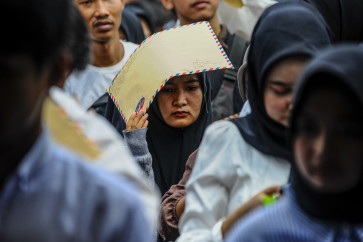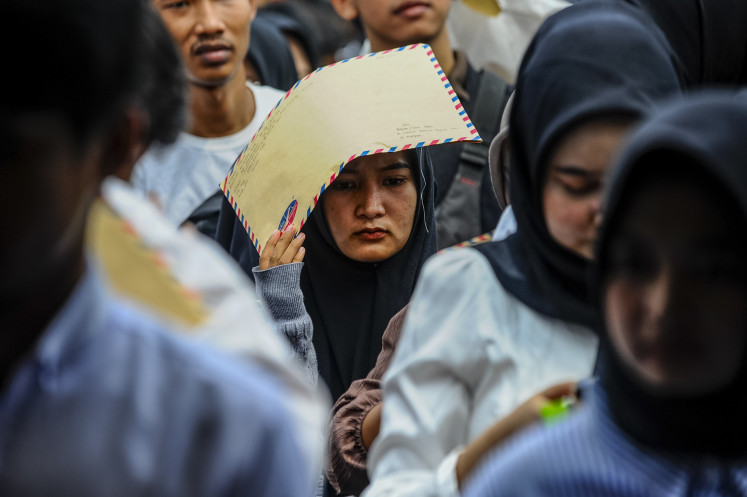Precious trees protected by local wisdom
Old and new: Namah Menu, the raja of Boti Dalam village, stands next to a cendana mother tree thought to be hundreds of years old
Change text size
Gift Premium Articles
to Anyone

Old and new: Namah Menu, the raja of Boti Dalam village, stands next to a cendana mother tree thought to be hundreds of years old.
A centuries-old sandalwood tree of the best species keeps growing, providing seedlings for present and future generations of the plant amid a world sandalwood scarcity, thanks to the wisdom of the indigenous Boti people in Timor, East Nusa Tenggara.
The Boti Dalam ethnic group lives in Boti village, Ki'e district, South Timor Tengah (TTS) regency, East Nusa Tenggara (NTT). It lies around 40 kilometers southeast of So'e, the TTS regency seat, or four hours' drive from the NTT provincial capital, Kupang.
As descendants of Timor islanders, Boti people are also called atoni meto, meaning 'people from dry land' in the local Dawan language. The regency's ethnic community is composed of the Boti Luar, inhabiting three other villages, and the Boti Dalam.
Boti Dalam villagers live in a verdant valley at an altitude of 520 meters with relatively difficult access. The village is reached through steep and winding tracks across hilly karst terrain offering mesmerizing views on both sides.
In this 16.5-square-kilometer village, hundreds of white sandalwood (Santalum album Linn) trees famous for their fragrance and high value are thriving, conserved by local tradition. Meanwhile, the so-called mother tree, a source of seedlings believed to be centuries old, still stands near the house of Boti ethnic community leader Raja Namah Benu and can only be observed in Raja's company.
Cendana (sandalwood) comes from the Dawan word cendan, meaning a spiritual tree. The Boti community's belief system, connected with the Earth and the sky, is called Halaika.
'Their faith is dynamism instead of animism. They believe in God and entrust their fate to their ancestors,' said Michael Riwu Kaho, a forestry lecturer at Cendana University in Kupang.
'We pray to nature so that nature also takes care of us and we do the same,' said Namah Benu, who always speaks Dawan, although he understands a little Indonesian. Raja has been the chief of around 300 Boti Dalam people since the demise of his father, Nune Benu, in 2005, and carries on the conservation and protection of sandalwood.

According to Raja, every resident in the village owns two or three sandalwood trees, meaning that more than 600 trees are growing there. As villagers are required to maintain friendly ties with nature, they are prohibited to fell trees at random, including sandalwood, also called haumeni.
Sandalwood felling is conducted by a ritual to determine the trees chosen. Community elders go around sandalwood trees to examine whether their stems already contain pith. Even large trees are not to be cut down if they have no pith, which is generally found at the age of 16 and above.
Conservation is also verbally attempted. At village meetings, Raja tells all residents, especially youths and children, about the importance of sandalwood and its mother tree for the continuity of future generations. 'Without replanting, we'll have no assets for future life. Trees are fruitful after 10-15 years,' said Raja.
While in most of the province, the fragrant trees are drastically shrinking in number, Boti Dalam people have nothing to worry about as they grow new seedlings, derived from the mother tree, in the rainy season around December. 'After December, sandalwood and other plants won't survive even with high rainfall, because soil acidity is reduced,' said Christian Koenenu, head of the Forest Rehabilitation division at the TTS Forestry and Plantation Agency.
As a safeguard, fines are imposed on sandalwood poachers in the form of one cow and a set amount of rice, besides a tough penalty on those damaging these trees. Some villagers used to burn their plots before growing seasonal crops. At the time, even if only the leaves of the sandalwood trees were burned, those responsible would be jailed in So'e if caught. 'Many poachers escaped, frequently leaving the stumps of pith-free sandalwood trees chopped down in vain,' added Christian.
Today, with the support of the International Tropical Timber Organization (ITTO), sandalwood management has been improved, particularly in terms of ownership and utilization. Sandalwood trees on community land are wholly owned by local people instead of by the government and their products also fully belong to the community. The government only manages sandalwood trading on community and state land.
But sandalwood theft, including in Boti, hasn't ceased yet, because perpetrators know that sandalwood felling on community land is not officially regulated, while the wood's selling price of Rp 1 million (US$70.70) per kilogram is a major draw. The offenders are locals, some even Boti Dalam people, and their buyers are outsiders. Raja deplores the sale of sandalwood by Boti Dalam children who attend school outside the village.
According to Michael Riwu, Boti Dalam people don't get schooling in the village because it's seen as disrupting their traditional system. Every family has children with formal and traditional education, while one child is left uneducated. Sadly, a trend has emerged of some of the state-educated children becoming delinquents.
Meanwhile, the customary rule banning sandalwood theft is seen as lenient and ineffective. This problem causes anxiety among Raja and the village elders.
For the protection of sandalwood, Boti Dalam people's long-standing conservation efforts also need government support.

Namah Benu has asked the government to issue a strict regulation to protect sandalwood trees from random felling. 'Everyone should also be obliged to grow the trees in their gardens or field,' said Raja. Only by local wisdom can haumeni survive on Timor.
Sandalwood has long been known as the identity and pride of East Nusa Tenggara, which produces fragrant timber and oil. The wood produces spice, incense, aromatherapy oil, perfume and sheaths for kris or traditional daggers. Good quality wood preserves its fragrance for centuries.
Sandalwood trees are not found in many places in the world. Those that grow on the islands of Timor, Sumba and Alor are known as Indian sandalwood (Santalum album), as it originated on the subcontinent. Timor's white sandalwood is the best variety.
Yani Septiani, the coordinator of the ITTO cooperation project for sandalwood development in NTT, said botanists had also described the quality of oil derived from NTT's sandalwood as the world's best.
'But when the plant is taken out of NTT and grown elsewhere, the quality won't be the same. It has to grow in the original place,' Yani added.
From the 1980s to the 1990s, sandalwood in NTT became scarce as a result of large-scale exploitation without proper replanting efforts. Local people were also unwilling to cultivate sandalwood as the provincial administration declared in 1986 that all sandalwood on community land was owned by the government, with only 20 percent of profits going to the owners.
In 2004 there was no sandalwood production, probably because of the scarcity of sandalwood trees. Based on data from the North Timor Tengah regency Forestry Agency, in 2012, only 45,428 trees grew in the regency, a sharp decline in numbers from the 1980s.
However, when greater regional autonomy was introduced in the late 1990s, bylaws were issued to transfer sandalwood management to regency administrations. In South Timor Tengah, Regency Bylaw No. 25/2001 restored the local people's right to grow sandalwood on private land and they have since been free to sell their own wood.
' Photos by Lily G. Nababan









